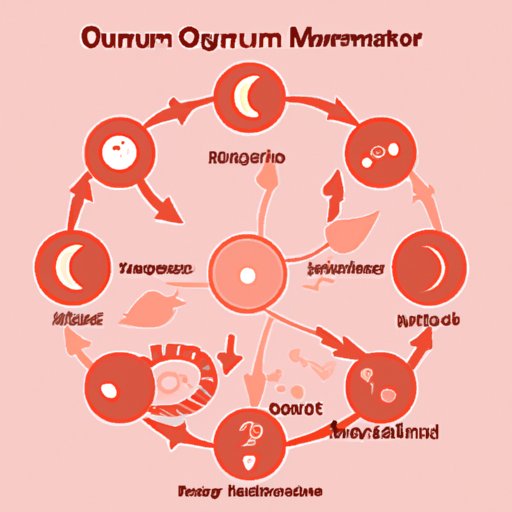
Introduction
Getting pregnant is an exciting and life-changing event for many couples. However, the journey to conception is not always straightforward. One of the most important factors in getting pregnant is understanding ovulation and fertility. In this comprehensive guide, we will explore everything you need to know about ovulation, from timing to symptoms, and provide practical tips on how to improve your chances of conception.
The Ultimate Guide to Understanding Fertility: Debunking the Myth of Only Ovulating on Day 14
Many people believe that ovulation occurs in the middle of a woman’s menstrual cycle- on day 14. While this may be true for some women, it is not a universal truth. Understanding the timing of ovulation is crucial for improving your chances of conception.
Ovulation is the process where a mature egg is released from the ovary and travels down to the fallopian tube, where it may be fertilized. The timing of ovulation is determined by the menstrual cycle- the time between the first day of your period to the day before your next period. The typical menstrual cycle length is 28 days, but it varies greatly from woman to woman and can range from 21 to 35 days or more. The most fertile days for a woman are two to three days before ovulation until the day of ovulation itself.
Other factors may affect ovulation timing, such as stress, illness, or hormonal imbalances. The best way to identify the day of your ovulation is through tracking your menstrual cycle and monitoring symptoms such as changes in your cervical mucus or basal body temperature.
Increase Your Chances for Conception: A Comprehensive Breakdown of Ovulation and Fertility
Ovulation is the key to getting pregnant. However, identifying your fertile days is not always easy. There are several ways to increase your chances of conception, such as timing intercourse during your fertile window.
Your fertile window is the time in your menstrual cycle when pregnancy is most likely to occur. This window varies depending on the length of your menstrual cycle. For example, a woman with a 28-day cycle is most likely to ovulate on day 14 and is fertile from days 11 to 14. However, a woman with a 35-day cycle is most likely to ovulate on day 21 and is fertile from days 18 to 21.
Other ways to increase your chances of conception include maintaining a healthy lifestyle, eating a balanced diet, and avoiding smoking and excessive alcohol consumption. Taking prenatal vitamins and seeing your doctor for regular check-ups can also help improve fertility and increase the chances of a healthy pregnancy.
Ovulation and Pregnancy: How to Recognize the Signs and Symptoms
Ovulation is a complex process that involves many physiological changes in a woman’s body. Learning how to recognize the signs and symptoms of ovulation can help increase your chances of fertility and conception.
One of the most reliable indicators of ovulation is changes in cervical mucus. During ovulation, cervical mucus becomes thinner and clearer to help facilitate sperm transport. Increased sexual desire and sensitivity in the breasts may also occur during ovulation. Other signs include slight increases in basal body temperature and abdominal pain or discomfort on one side of the pelvis.
Common ovulation-related issues, such as irregular periods, can make it more difficult to identify ovulation and increase the chances of conception. In these cases, monitoring symptoms and tracking the menstrual cycle can help identify fertile windows and provide guidance for timing intercourse.
The Science Behind Ovulation: Understanding How Your Body Works
The menstrual cycle and ovulation are regulated by a complex sequence of hormonal changes in a woman’s body. Hormones, such as estrogen and progesterone, play a crucial role in regulating the menstrual cycle and ovulation.
The menstrual cycle is divided into three phases: the follicular phase, ovulation, and the luteal phase. Each phase is marked by different levels of hormones and physiological changes in the body that culminate in ovulation.
Other factors, such as polycystic ovary syndrome (PCOS), can affect ovulation and fertility. PCOS is a hormonal disorder that affects up to 10% of women of reproductive age and can lead to irregular menstrual cycles and ovulation problems. Making healthy lifestyle changes, such as losing weight and exercising, can help improve fertility and reduce the risk of ovulation-related issues.
Common Misconceptions About Getting Pregnant During Ovulation
There are many misconceptions about ovulation and getting pregnant that can lead to frustration and disappointment for couples trying to conceive. One of the most common myths is that having sex every day increases the chances of conception. However, this is not true. In fact, having sex too often can lower sperm count and reduce the chances of conception.
Other myths include the belief that certain sex positions or timing can affect the gender of the baby or that infertility is always a female issue. Understanding the facts about fertility and conception can help dispel these myths and provide guidance for couples trying to conceive.
Conclusion
Ovulation is a critical factor in getting pregnant, and understanding your menstrual cycle and fertile window is crucial for improving your chances of conception. By staying informed about ovulation and fertility issues, making healthy lifestyle choices, and seeking medical guidance when needed, couples can take proactive steps to achieve their dream of starting a family.
For further information on fertility and ovulation, consider consulting with a gynecologist or reproductive endocrinologist or check out recommended resources such as “Taking Charge of Your Fertility” by Toni Weschler or “The Impatient Woman’s Guide to Getting Pregnant” by Jean Twenge, PhD.




